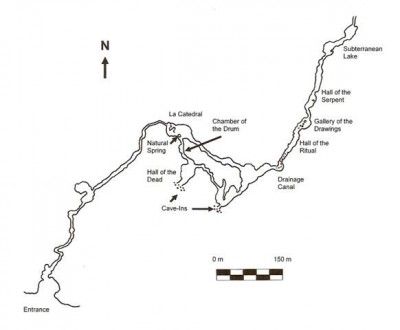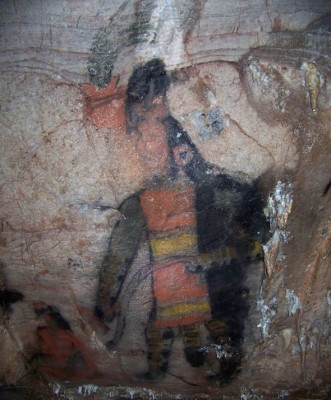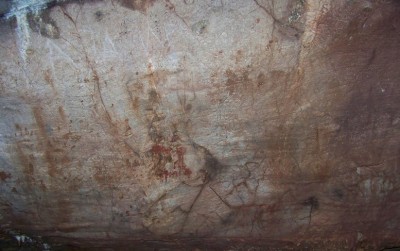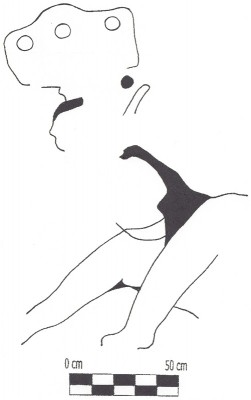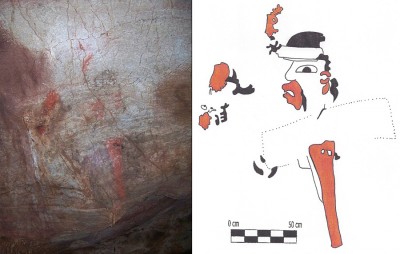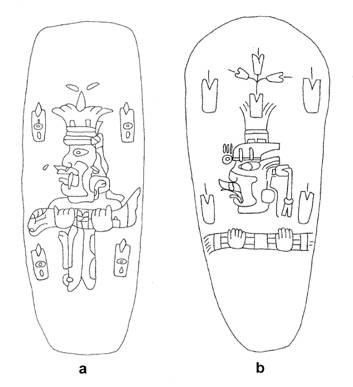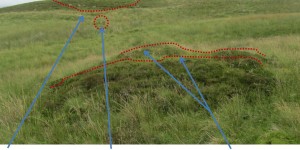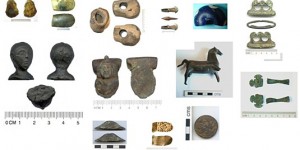1972 for a comparison with the personages at Chalcatzingo Monument 2, Carlo Gay published a drawing of the famous Olmec-style mural, known as Painting 1, from Juxtlahuaca Cave in Mexico. This drawing that not only showed two well-known paintings – one depicting an elite figure wearing a jaguar pelt; the other consisting of a smaller seated figure – but also portrayed two badly eroded paintings to the right of these more famous compositions. To my knowledge, no other researcher has documented these new rock paintings or attempted to shed light on their potential meaning since Gay’s initial work. In this brief report, I shall describe these two figures in an attempt to restore the archaeological significance of Juxtlahuaca Painting 1.
Juxtlahuaca Cave overlooks the Río Blanco valley and is located northeast of the modern village of Juxtlahuaca, in the Mexican state of Guerrero. Both the village and the site can be reached along a semi-paved road from the town of Colotlipa, which is located approximately 78 km to the east of the state capital, Chilpancingo. The cave is composed of travertine and contains extensive calcite formations in hues of white, pink, and yellow. Although vegetation makes the cave difficult to observe from the valley floor and there are no known surface sites in the immediate vicinity; evidence of human activity within the cave extends approximately 1500 m under the ground (Figure 1).
The Olmec-style rock paintings at Juxtlahuaca Cave were first documented by Carlo Gay and Gillett Griffin in 1966 (Gay 1967; Griffin 1967; Griffin 1981; Griffin 1982). Representing some of the earliest datable painted murals in Mesoamerica, these rock paintings soon drew the attention of other scholars (Coe 1968; Coe 2005; de la Fuente 1999; Foncerrada de Molina 1972; Freeman 1994; Greer and Greer 1998; Grove 1967; Grove 1970; Grove 2000; Niederberger Betton 1996; Stone 1995).
Although the cave contains paintings of a serpent (Juxtlahuaca Painting 2) and a feline (Juxtlahuaca Painting 3) in addition to several other drawings (Gay 1967, 30-35; Griffin 1981, 211, Figure 3; Grove 1967, 39; Stone 1995, 47), the most well-known rock painting at the site (Juxtlahuaca Painting 1) depicts a ruler clad in elaborate clothing, including jaguar skins, a striped tunic, and a headdress topped with blue-green plumes (Figure 2). This imposing figure stands in marked contrast to a much smaller, seated figure to the east of the ruler. This seated figure is dressed in red, wears a dark mask, and is shown holding an object.
Juxtlahuaca Painting 1
Located on the right wall as you enter the so-called ‘Gallery of Drawings’, Painting 1 consists of a mural containing four distinct anthropomorphic figures (hereafter designated as Figures A, B, C, and D in order from east to west). Figures A and B are the most well-known and were first reported by Carlo Gay and Frances Pratt in 1967 (Figure 2).
Figure A depicts a reddish, seated human figure rendered in frontal view. This personage is disproportionately small compared to the other figures in the mural. The figure’s head is shown in profile, apparently masked. A single red plume extends from the figure’s head. In addition, the personage depicted in Figure A is seated in a cross-legged position and appears to be holding a small object, possibly a bundle or ceremonial bar.
Figure B faces Figure A and consists of a much larger standing figure interpreted as a ruler, perhaps a divine impersonator or a person of high social standing transforming into their animal alter ego (Stone 1995, 47; Reilly and Garber 2003, 136). The figure is shown in frontal view but the head is rendered in profile. As befits his high status, this personage is dressed in elaborate clothing consisting of a tunic with red and tan stripes, a black cloak, a black headdress or cowl decorated with blue-green feathers and a circular ear ornament, as well as arm and leg sheaths decorated with jaguar skins. A large jaguar’s tail is displayed between the ruler’s legs. This figure is also shown holding a rope-like object in his left hand and a barbed object in his right hand.
Figures C and D were originally found by Carlo Gay and his party in 1968 (Gay 1972, 48). Figure C consists of a highly eroded monochrome depiction of a human personage rendered in profile view and outlined with black pigment. The visible sections of the figure include sections of an elaborate headdress and a black cowl covering the back of the figure’s head, as well as the figure’s arms and upper torso. The figure’s lower torso and legs are missing (Figure 3).
Taken as a whole, the personage in Figure C appears to be leaning forward on their arms in a manner reminiscent of the high relief carvings of niche figures on the thrones from the Gulf Coast lowlands, such as La Venta Altar 4 (Stirling 1943, Plate 37a). Apart from the headdress, the figure appears to be relatively undecorated. The headdress consists of a large rectangular panel decorated with three circles arranged in a horizontal line, the outline of an anthropomorphic diadem, and a tassel towards the rear of the headdress (Figure 4). The figure’s black cowl is similar in form to the cowl seen on Figure B although no ear ornament is present in Figure C. A collar is also faintly visible under the figure’s jaw line.
Although also highly eroded, Figure D is a polychrome rock painting (Figure 5). Gay’s original rendition and description of this painting suggested that it consisted of a human figure decorated with an orange-red pigment and clothing outlined in black paint (Gay 1972, 51, Figure 21a). A re-examination of Figure D suggests a different interpretation of the subject matter.
Based on careful analysis of the remains of the painting, it appears that Figure D depicts a masked anthropomorphic character, rendered in profile view and holding a large rectangular object whose outlines are visible only in relation to the surviving portions of the painting (Figure 6). The human figure is decorated with a large round black headdress with orange plumes in the front. The figure’s eye is almond-shaped. The buccal mask is rendered in orange pigment and is similar to the fanged zoomorphic masks worn by the carved figures in Chalcatzingo Monument 2 (Angulo 1987, 143, Figure 10.14a). The back of the figure’s head consists of an undulating black cowl along with an orange ear ornament.
Three sharp finger-like projections are visible to the east of the figure. These appear to be holding the rectangular object. A single reddish projection, possibly a highly schematised leg, is also shown descending from the area of the rectangular object, although no feet are discernable. The probable outlines of a hip cloth or loin cloth are depicted next to this schematic leg.
Finally, a series of red and black designs are visible between Figures C and D. These are located close to Figure D and were probably originally associated with this rock painting. The black designs appear to represent the remnants of a tassel, two eyes, and an undulating black cowl. Although the upper red design is indistinct, the lower red design may depict a buccal mask. If these observations are correct, then this small painting may originally have been a miniature copy of Figure D.
A new interpretation of Juxtlahuaca Painting 1
Based on his observations, Carlo Gay (1972, 48) argued that the four figures in Juxtlahuaca Painting 1 mirror the position and posture of the figures in Chalcatzingo Monument 2. In both cases, an outlying figure is shown in a seated or recumbent position and is confronted by three other figures with more commanding postures as well as other markers of elite status. As such, Juxtlahuaca Painting 1 may present the viewer with a narrative scene involving four personages participating in a ritual linked to an iconography of power.
By contrast, my observations suggest a slightly different interpretation of Juxtlahuaca Painting 1 in which the mural consists of three separate groups, each with its own theme. The first two personages, Figures A and B, form the first group. In this grouping, Figure B is shown with many of the material trappings of elite status, i.e. elaborate clothing (such as the plumed headdress and jaguar pelt), and being depicted as much larger than the seated figure represented by Figure A. This suggests that the painters of Figures A and B were familiar with a common trope in Formative and Classic period imagery to mark distinctions in rank or social condition (i.e. authority/follower, captor/captive, or main personage/attendant) (2).
The second group is made up of Figure C and appears to refer to another common trope in Olmec-style art, i.e. a ruler or ancestor emerging from a cave or niche (3). The posture of the figure is identical to the niche figures found on La Venta Altar 4 (Stirling 1943, Plate 37a), San Lorenzo Monument 14 (Cyphers 2004, 71, Figure 30), and Chalcatzingo Monument 13 (Angulo 1987, 141, Figure 10.12). Furthermore, the figure’s elaborate headdress and diadem suggest that Figure C rendered an elite personage, possibly a ruler. This pattern suggests that the painters of Figure C were aware of the associations of cave imagery with rulership.
Finally, the third group consists primarily of Figure D but may also involve the small polychrome design to the east of the figure. This scene refers to yet another common trope to legitimise elite status, i.e. a ruler bearing a ceremonial bar. Although a similar scene involving the seated figure of a ruler is depicted in Chalcatzingo Monument 1 (Angulo 1987, 137, Figure 10.8), closer parallels are to be found on the jade celts from Río Pesquero in the Gulf Coast lowlands of Veracruz (Figure 7). In both of these examples, a ruler with an elaborate plumed headdress, circular ear ornament and a buccal zoomorphic mask is shown holding a ceremonial bar. Moreover, in at least one example (Figure 7a), the ruler is shown with schematic legs just like Figure D from Juxtlahuaca. Taken together, these correspondences suggest that the painters of Figure D had been previously exposed to this theme from Middle Formative period rock carvings and celts.
Conclusions
Although it is difficult to arrive at any definitive conclusions regarding the ultimate meaning that Juxtlahuaca Painting 1 held for the peoples of Formative Guerrero, with the fragmentary nature of the data making alternative interpretations possible, this report has attempted to help the scholarly community re-imagine the significance of this famous Olmec-style mural by providing new descriptions of Figures C and D.
In so doing, it has become clear that Juxtlahuaca Painting 1 did not form a single cohesive narrative as was originally envisioned by Carlo Gay (1972). Rather, it appears that this mural actually consists of three distinct groups of paintings, each representing a common trope in Olmec-style art. Figures A and B seem to refer to the use of an iconography of power which differentiates between rulers and followers by their relative sizes; while Figure C represents a ruler emerging from a cave and Figure D appears to show an elite personage holding a ceremonial bar. If this interpretation is correct, then it is probable that the distinct groups of rock paintings which compose Juxtlahuaca Painting 1 were made by separate rulers over a long period of time as a way to assert their right to rule or by a single ruler attempting to legitimate his or her status by using different artistic tropes.
These possibilities further suggest that the deployment of Olmec-style art at Juxtlahuaca cave, perhaps along with its use at Oxtotitlán and Cauadzidziqui, represents dynamic, site-specific strategies by which Formative period rulers sought to augment their relative status vis-a-vis other individuals or groups in their respective Formative period communities. It is therefore important to consider the likelihood that the painted caves of eastern Guerrero were not simply the loci of ritual activity but were also sites of symbolic conflict.
Notes
- The observations described in this paper were made during two visits to Juxtlahuaca Cave in January and March 2010.
- Other examples of this well-known trope in Olmec-style art include La Venta Stela 2 (Drucker 1952, 174, Figure 49), Carving B from Pijijiapan Boulder 2 (Navarrete 1974, 6-7, Figures 4-5), and Cauadzidziqui Paintings 1 and 2 (Villela 1989, 42, Figure 2).
- By depicting human beings sitting within or emerging out of niches, niche figures have been interpreted as symbolic references to the act of emerging from the underworld (see Grove 1973; Stone 1995).
Bibliography
- Angulo, J. (1987) ‘The Chalcatzingo Reliefs: An Iconographic Analysis’, in D.C. Grove (ed.) Ancient Chalcatzingo. 132-158. Austin: University of Texas Press
- Coe, M. (1968) America’s First Civilization. New York: American Heritage
- Coe, M. (2005) ‘Image of an Olmec Ruler at Juxtlahuaca, Mexico’. Antiquity. 79 (305). Project Gallery, http://www.antiquity.ac.uk/projgall/coe305/ [Accessed 13th March 2012]
- Cyphers, A. (2004) Escultura Olmeca de San Lorenzo Tenochtitlán. Mexico City: Universidad Nacional Autónoma de Mexico
- de la Funete, B. (1999) ‘The Background: Olmec Painting’ in B. de la Fuente (ed.) The Pre-Columbian Painting Murals of Mesoamerica. 12-16. Milan: Editoriale Jaca Book
- Drucker, P. (1952) ‘La Venta, Tabasco: A Study of Olmec Ceramics and Art’. Bureau of American Ethnology, Bulletin. 153. Washington D.C.: Smithsonian Institution
- Foncerrada de Molina, M. (1972) ‘La Pintura Rupestre / Rock Painting’. Artes de Mexico. 29 (154). 63-67
- Freeman, P. (1994) ‘In Search of the Olmec’. Bay Area Rock Art News. 12 (3). 1-2
- Gay, C. (1967) ‘Oldest Paintings of the New World’. Natural History. 76 (4). 28-35
- Gay, C. (1972) Chalcacingo. Portland, Oregon: International Scholarly Book Services
- Greer, J. and Greer, M. (1998) ‘Dark Zone Rock Art in North America’, in K. Hedges (ed.) Rock Art Papers. 13. 135-144. San Diego: San Diego Museum of Man
- Griffin, G. (1967) ‘Cave Trip discloses Earliest American Art’. University. 34. 6-9
- Griffin, G. (1981) ‘Olmec Forms and Materials Found in Central Guerrero’, in E.P. Benson (ed.) The Olmec and Their Neighbors: Essays in Honor of Matthew W. Stirling. 209-222. Washington D.C.: Dumbarton Oaks/Trustees of Harvard University
- Griffin, G. (1982) ‘Una Representacion Olmeca de Arquitectura en las Pinturas Rupestres de Juxtlahuaca’, in D. Schavelzon (ed.) Las Representaciones de Arquitectura en la Arqueología de América. 44-46. Mexico City: Universidad Nacional Autónoma de Mexico
- Grove, D.C. (1967) ‘Juxtlahuaca Cave (Guerrero) Revisited’. Katunob. 6 (2). 37-40
- Grove, D.C. (1970) ‘The Olmec Paintings of Oxtotitlán Cave, Guerrero, Mexico’. Studies in Pre-Columbian Art and Archaeology. 6. Washington D.C.: Dumbarton Oaks/Trustees for Harvard University
- Grove, D.C. (1973) ‘Olmec Altars and Myths’. Archaeology. 26 (3). 94-100
- Grove, D.C. (2000) ‘Faces of the Earth at Chalcatzingo, Mexico’, in J. Clark and M. Pye (eds.) Olmec Art and Archaeology. Studies in the History of Art. 58. New Haven: Yale University Press. 276-295
- Joralemon, P. (1976) ‘The Olmec Dragon: A Study in Pre-Columbian Iconography’, in H.B. Nicholson (ed.) Origins of Religious Art and Iconography in Preclassic Mesoamerica. UCLA Latin American Studies Series. 31. Los Angeles: UCLA Latin American Center / Ethnic Arts Council of Los Angeles. 27-71
- Navarrete, C. (1974) ‘Olmec Rock Carvings at Pijijiapan, Chiapas, Mexico and Other Olmec Pieces from Chiapas and Guatemala’. Papers of the New World Archaeological Foundation. 35. Provo: Brigham Young University, New World Archaeological Foundation
- Niederberger Betton, C. (1996) ‘Olmec Horizon Guerrero’, in E.P. Benson and B. de la Fuente (eds.) Olmec Art of Ancient Mexico. 95-103. Washington D.C.: National Gallery of Art / Harry N. Abrams, Inc.
- Reilly, F.K., III, and Garber, J.F. (2003) ‘The Symbolic Representation of Warfare in Formative Period Mesoamerica’ in M.K. Brown and T.W. Stanton (eds.) Ancient Mesoamerican Warfare. 127-148. New York: Altamira Press
- Stirling, M.W. (1943) ‘Stone Monuments of Southern Mexico’. Bureau of American Ethnology, Bulletin. 138. Washington D.C.: Smithsonian Institution
- Stone, A. (1995) Images from the Underworld: Naj Tunich and the Tradition of Maya Cave Painting. Austin: University of Texas Press
- Villela, S. (1989) ‘Nuevo Testimonio Rupestre Olmeca en el Oriente de Guerrero’. Arqueología. 2. 37-48


